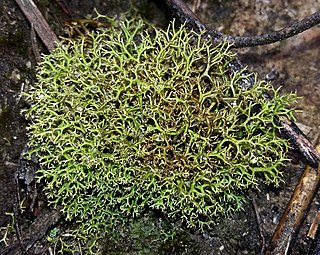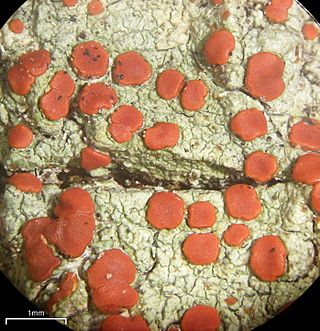
Cladia is a genus of lichenized fungi in the family Cladoniaceae. Cladia species have a crustose primary thallus and a fruticose, secondary thallus, often referred to as pseudopodetium. The type species of the genus, Cladia aggregata, is widely distributed, occurring from South America, South Africa, Australasia and South-East Asia to southern Japan and India. Most of the other species are found in the Southern Hemisphere.
Kantvilasia is a lichen genus in the family Pilocarpaceae. This is a monotypic genus, containing the single species Kantvilasia hians.

Lecidella is a genus of crustose lichens in the family Lecanoraceae.

Ramboldia is a genus of lichen-forming fungi in the family Ramboldiaceae. The genus was circumscribed in 1994 by Gintaras Kantvilas and John Alan Elix. It was emended in 2008 by the inclusion of Pyrrhospora species containing the anthraquinone russulone in their apothecia and having a prosoplectenchymatous exciple. The family Ramboldiaceae was circumscribed in 2014 to contain the genus.

Rhizocarpon is a genus of crustose, saxicolous, lecideoid lichens in the family Rhizocarpaceae. The genus is common in arctic-alpine environments, but also occurs throughout temperate, subtropical, and even tropical regions. They are commonly known as map lichens because of the prothallus forming border-like bands between colonies in some species, like the common map lichen.
Siphulella is a fungal genus in the Icmadophilaceae family. The genus is monotypic, containing the single lichen species Siphulella coralloidea, found in southwest Tasmania. The genus and species were described as new to science in 1992 by Gintaras Kantvilas, John Elix and Peter James. The genus name is based on the superficial resemblance that S. coralloidea has to some species in the genus Siphula.
Megalaria is a genus of lichen-forming fungi in the family Ramalinaceae. The genus was circumscribed by Austrian lichenologist Josef Hafellner in 1984, with Megalaria grossa assigned as the type species.

Tephromela is a genus of lichens in the family Tephromelataceae. There are about 25 species in this widespread genus.

Mycoblastus is a genus of crustose lichens in the family Tephromelataceae. Members of the genus are commonly called blood lichens.

Hertelidea is a genus of crustose lichens in the family Stereocaulaceae. Characteristics of the genus include carbon-black ring or outer margin (exciple) around the fruit body disc (apothecium), eight-spored, Micarea-type asci and mostly simple, hyaline ascospores that lack a transparent outer layer. Hertelidea species mostly grow on wood, although less frequently they are found on bark or soil. While the type species, Hertelidea botryosa, has a widespread distribution, most of the other species are found only in Australia.
Josef Hafellner is an Austrian mycologist and lichenologist. He was awarded the Acharius Medal in 2016 for his lifetime contributions to lichenology. Before his retirement, he was a professor at the Karl-Franzens-Universität in Graz. Hafellner started developing an interest in lichens while he was a student at this institution, studying under Josef Poelt. He earned a master's degree in 1975 and a PhD in 1978, defending a doctoral thesis about the genus Karschia. In 2003, Hafellner received his habilitation. By this time, he had studied with French lichenologist André Bellemère (1927–2014) at Saint-Cloud, where he learned techniques of transmission electron microscopy and how their application in studying asci could be used in lichen systematics. His 1984 work Studien in Richtung einer natürlicheren Gliederung der Sammelfamilien Lecanoraceae und Lecideaceae has been described as "probably the single most influential publication in lichen systematics in the latter half of the 20th century".
Gintaras Kantvilas is an Australian lichenologist, who earned his Ph.D in 1985 from the University of Tasmania with a thesis entitled Studies on Tasmanian rainforest lichens. He has authored over 432 species names, and 167 genera in the field of mycology.
Amandinea devilliersiana is a species of crustose lichen in the family Caliciaceae, and found in South Australia. It was first described in 2013 by Australian lichenologists Jack Elix and Gintaras Kantvilas from a specimen collected on a granite boulder near the seashore in South Australia. The species epithet, devilliersiana, honours Brigitte de Villiers. Specimens used for the description came from both Tasmania and South Australia.
Punctelia transtasmanica is a species of foliose lichen in the family Parmeliaceae. It is found in Australasia.
Punctelia pseudocoralloidea is a species of foliose lichen in the family Parmeliaceae. It is found in Australia, where it grows on bark and on wood.
Helmut Mayrhofer is an Austrian lichenologist. He is known for his expertise on the lichen family Physciaceae and his studies of the lichen flora of the Balkan Peninsula, the Alps, and other regions.

Megalospora is a genus of lichen-forming fungi in the family Megalosporaceae.
Ramboldia blastidiata is a species of saxicolous (rock-dwelling) and crustose lichen in the family Lecanoraceae. Found in Australia, it was formally described as a new species in 2007 by lichenologists Gintaras Kantvilas and John Elix. The type specimen was collected by the first author from the western slopes of Strzelecki Peaks on Flinders Island (Tasmania) at an altitude of 150 m (490 ft); here, in dry sclerophyll forest, it was found growing on a granite boulder. The lichen forms pale grey-green, olive-green to dull olive-brown crust-like patches up to 30 cm (12 in) wide. The authors suggest that it is widespread in temperate Australia and Tasmania, but not commonly collected. Others saxicolous lichens that it usually grows with include Ramboldia petraeoides, Lecanora farinacea, Xanthoparmelia mougeotina, and species from the genera Buellia and Rhizocarpon. The specific epithet blastidiata refers to the presence of blastidia, which are vegetative propagules that contain mycobiont and photobiont and are produced by yeast-like budding.
Xanthoparmelia canobolasensis is a lichen which belongs to the Xanthoparmelia genus. It is found in the Australian states of New South Wales and Tasmania. Although not currently endangered it appears to fulfill the criteria under the Tasmanian Threatened Species Protection Act 1995.
Megalaria hafellneriana is a species of crustose lichen in the family Ramalinaceae. Found in Tasmania, Australia, it was formally described as a new species in 2016 by lichenologist Gintaras Kantvilas. The species epithet honours Austrian lichenologist Josef Hafellner, who circumscribed the genus Megalaria and, according to the author, "undertook some of the pioneering, albeit unpublished research on Australian species".







